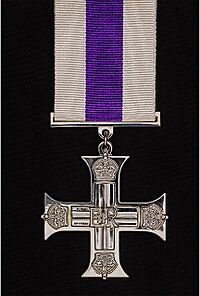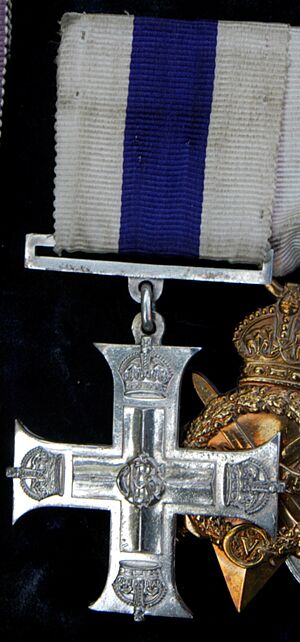Military Cross facts for kids
Quick facts for kids Military Cross |
|
|---|---|

Military Cross
|
|
| Awarded for | Obverse: Straight armed silver cross, Royal Cypher in centre Reverse: plain |
| Presented by | United Kingdom and Commonwealth |
The Military Cross (often called the MC) is a special award given to members of the British Armed Forces. It's given for showing great bravery during battles on land. Until 1993, it was the second-highest award for bravery. Now, it's the third-highest.
This award can be given to any soldier, no matter their rank. Since 1979, it can even be given after someone has passed away.
Contents
History of the Military Cross
How the Award Started
The Military Cross was created on 28 December 1914, during World War I. It was first given to army officers who were captains or below, and to warrant officers. The very first awards were announced on 1 January 1915. Ninety-eight people received it, including 71 officers and 27 warrant officers. Even though it usually wasn't given after someone died, seven of these first awards were for people who had passed away from their injuries.
Changes Over Time
From August 1916, people who received the MC could put "MC" after their name. If they showed bravery again, they could get a "bar" added to their medal. This bar is a small silver strip on the ribbon.
In June 1917, the award could also be given to temporary majors. Later, in 1953, all majors became eligible. In 1931, the award was extended to members of the Royal Air Force for brave actions on the ground.
After World War II, many Commonwealth countries, like Canada, Australia, and New Zealand, started their own awards. This meant they no longer recommended people for British awards like the Military Cross.
The 1993 Changes
In 1993, the British awards system was updated. The Military Medal, which was for bravery by soldiers of lower ranks, was stopped. The Military Cross then became an award for all ranks in the British Armed Forces. It is given for "exemplary gallantry" (meaning amazing bravery) on land. This bravery is not quite at the level needed for the Victoria Cross (the highest award) or the Conspicuous Gallantry Cross.
What the Military Cross Looks Like
The Military Cross was designed by Henry Farnham Burke. Its ribbon was created by Victoria Ponsonby, Baroness Sysonby.
Here's what the medal looks like:
- It's a silver cross with straight arms.
- It has crowns on it, with the King or Queen's special symbol in the middle.
- The back of the medal is plain.
- From 1938 to 1957, the year it was awarded was carved on the back. Since 1984, the recipient's name has been added.
- The ribbon is 32 mm wide. It has three equal stripes: white, purple, and white.
- If someone gets another award (a "bar"), it's a plain silver bar with a crown in the middle.
Recipients of the Military Cross
How Many Awards Have Been Given?
Since 1914, more than 52,000 Military Crosses have been awarded. Also, 3,717 "bars" (extra awards for more bravery) have been given.
Here's a quick look at how many were given during different periods:
| Period | Medals | 1st bar | 2nd bar | 3rd bar | Honorary MCs |
|---|---|---|---|---|---|
| World War I | 37,104 | 2,984 | 169 | 4 | 2,909 |
| World War II | 10,386 | 482 | 24 | – | 438 |
| Total (1914–1979) | 48,482 | 3,517 | 193 | 4 | 3,347 |
Since 1979, about 375 more Military Crosses have been awarded. These include awards for bravery in places like Northern Ireland, the Falklands War, and conflicts in the Persian Gulf, Iraq, and Afghanistan.
Famous Recipients
- During World War I, Captain Francis Wallington was the first person to receive the MC and three bars. This means he earned the award four times!
- The cities of Verdun and Ypres in France and Belgium were also given the Military Cross for their important roles in World War I.
- During World War II, Captain Sam Manekshaw of the Indian Army was badly wounded in Burma. A general quickly pinned his own Military Cross ribbon on Manekshaw, saying, "A dead person cannot be awarded a Military Cross." Manekshaw survived and later became a Field Marshal.
- The first Military Cross given after someone died was to Captain Herbert Westmacott in 1980 for his bravery in Northern Ireland.
- The first woman to receive the Military Cross was Private Michelle Norris in 2006. She was part of the Royal Army Medical Corps and earned it for her actions in Iraq. Queen Elizabeth II personally gave her the medal.
- Able Seaman Kate Nesbitt was the second woman, and the first in the Royal Navy, to receive the MC. She earned it in 2009 for her actions as a Medical Assistant in Afghanistan.
- Sergeant Michael Lockett, who received the MC in 2008, was killed in action in Afghanistan in 2009. He was the first MC holder to die in action since World War II.

See also
 In Spanish: Cruz Militar para niños
In Spanish: Cruz Militar para niños
- Category:Recipients of the Military Cross
- British and Commonwealth orders and decorations
- List of British gallantry awards for the Iraq War


